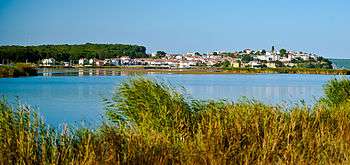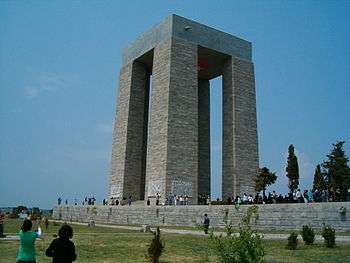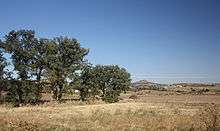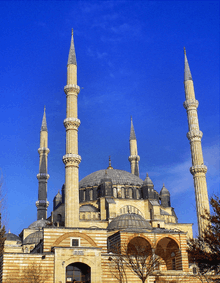Eastern Thrace
Eastern Thrace (Doğu Trakya in Turkish, although almost always called simply Trakya, i.e. Thrace) constitutes the European part of Turkey and forms the northwestern edge of the country.
Provinces
- Çanakkale Province (partially)
- Edirne Province
- Kırklareli Province
- Tekirdağ Province
Geographically, the western half of Istanbul Province is also part of Eastern Thrace.
Cities
Istranca Mountains and the Black Sea coast

Lush mountains, lakes, and desolate beaches
- 🌍 Demirköy — A town surrounded by forests up in Istranca Mountains, known for its 15th century foundry
- 🌍 İğneada — Long and sandy beaches where you'll have a hard time seeing someone else in the next kilometre, baсked by many lakes and one of the few floodplain forests in Europe
- 🌍 Kıyıköy — Still widely known by its traditional name of Midye among locals, this is a town with many traditional wooden houses, preserved city walls, and a monastery carved into rocks
- 🌍 Saray — Inland town serving as a hub for surrounding region, with a 16th-century Ottoman mosque
- 🌍 Vize — Town on the foothills of Istranca Mountains not very far from Black Sea coast, known for its Byzantine cathedral-turned-mosque called Little Hagia Sophia
Thracian Plains
Gently rolling plains covering the interior of the region; with towns, most of which have some artifacts dating back to the Ottoman period, lying on the major routes between Istanbul and Europe.
- 🌍 Babaeski — A town with an old mosque and a medieval bridge spanning a creek flowing through a tranquil, green meadow
- 🌍 Çerkezköy — A city with much industry
- 🌍 Çorlu — The newly emerging major city of the region, with even more industry
- 🌍 Edirne — The second capital of the Ottoman Empire, chock full of history; even the Selimiye Mosque alone is well worth the trip to this beautiful city
- 🌍 İpsala — small town on the Greek border
- 🌍 Keşan — A city in the western part of the region, near the Greek border; located on an important crossroad
- 🌍 Kırklareli — A city in the north, near the Bulgarian border, with a quite well preserved old quarter full of traditional wooden and neo-classical architecture
- 🌍 Lüleburgaz — The geographical center of Eastern Thrace with a sixteenth century mosque and accompanying covered bazaar
- 🌍 Uzunköprü — The name of which translates "the long bridge" in Turkish, this town has one of the longest stone bridges in anywhere nearby (more than a kilometre across), built in the 15th century
Marmara and Aegean coasts
Miles of beaches, stony and sandy, crowded and lonely alike; fishing towns, vineyards, and pine forests here and there
- 🌍 Eceabat — main town on Gallipoli Peninsula, serving as a hub to WWI memorials
- 🌍 Enez — a small town on the Maritsa delta, where Maritsa River empties into the Aegean Sea; a quite well-preserved Byzantine citadel and long sandy beaches are the main attractions
- Erikli-Mecidiye — two of the most popular resorts on the Saros Bay shore
- 🌍 Gelibolu — historical town on the Straits of Dardanelles, at the base of the peninsula known by the same name (Gallipoli)
- 🌍 Kilitbahir — a pretty village near the southern tip of the Gallipoli Peninsula, with an impressive castle on the Dardanelles
- Kumbağ — main nightlife spot of Eastern Thrace, with some kitschy bars and (overcrowded) beaches
- 🌍 Marmara Ereğlisi — site of ancient city of Perinthos, once administrative centre of the region, now a small town
- 🌍 Şarköy & Mürefte — these pleasant towns are at the centre of the wine country of the region, with nice beaches and some Greek architecture left from the former inhabitants
- Silivri — a town rapidly changing into a suburb of Istanbul
- 🌍 Tekirdağ — pleasant coastal city with some traditional wooden architecture, and where 18th century Hungarian independence leader, Ferenc Rakoczi II, was exiled
Geographically speaking, the city of Istanbul is also partially in Eastern Thrace, but culturally it is a world apart and should be considered as a region on its own.
Other destinations

- Dupnisa Cave — deep in the forest on the Istranca Mountains, an impressive and easily visitable cave with an underground creek, stalactites, and bats
- 🌍 Gallipoli — site of 1915 ANZAC landing and many World War I memorials; in the southwest of the region
- Kastro — Black Sea beach with sand lilies, backed by a beautiful forest
- Saros Bay — an indentation of Aegean Sea between Thracian mainland and Gallipoli peninsula, popular among scuba divers as this gulf is one of the cleanest and liveliest (in terms of marine ecology) bodies of water in all of Turkey
Islands
- 🌍 Gökçeada (Imbros) — the largest Turkish island, home to a small Greek community and abandoned villages
- 🌍 Marmara Island — although nearer to Asian mainland, this island has extensive transportation and cultural links with Eastern Thrace; site of a marble quarry with unfinished Roman sculptures and picturesque villages
Understand
Eastern Thrace is located in the northwestern corner of Turkey and makes up 3% of the country's landmass. Although this percentage might seem small at first, Eastern Thrace is only slightly smaller than whole of Belgium, for example.
Eastern Thrace is essentially a peninsula surrounded by Greece (Western Thrace) and Bulgaria (Northern Thrace) to the west and north respectively and bouded by Black Sea, Bosphorus, the Sea of Marmara, Dardanelles, and the Aegean Sea to the northeast, east, south, and southwest respectively.
Central parts of Eastern Thrace are dominated by Thracian plains, which are fairly... well, plain. These plains produce much of the country's wheat and sunflower, and a ride through in sunflower season (July) is indeed very pleasant amongst yellow flowers. However, being one of the powerhouses of Turkish economy, more east you go on the plains, less agricultural the landscape becomes—around Çerkezköy and north, west, and east of Çorlu is essentially nothing other than urban conglomeration going hand in hand with endless rows of factories. Northeastern coast and its adjacent area, on the other hand, is dominated by low-lying range of Istranca Mountains covered with lush broadleaf forests, typical of Turkish Black Sea coast, as well as the northern reaches of the region along the Bulgarian border. Southwestern parts dominated by Ganos and Koru Mountains, another low lying mountain range, and Gallipoli Peninsula are covered mostly with pine forests, in addition to vast vineyards on the foothils of Ganos Mountain, which supply almost half of Turkey's wine production.
Culture of today's Eastern Thrace shares many similarities with cultures of Balkan (Southeastern Europe) countries as much of the region's population is descended from people who immigrated from those countries starting in the late 1800s.
Eastern Thrace is a part of Marmara Region.
History

Thracians, an ancient people speaking an Indo-European language and whom the larger area surrounding the region was named after (which derived from the Thracian Zrayka) were the native folk of the region. Except a brief period during Odrysian Kingdom (5th–3rd century BC), these warrior tribes never formed a united nation. Except for landmark-ish tumulii, which they erected for their nobles as monumental tombs, not much other than some ruins and artifacts hardly distinguishable from natural formations by untrained eyes is left physically from this period, although some villages and rivers across the region still carry names that are phonetically corrupted forms of their original Thracian names.
Around 4000 BC, Greek colonists from Aegean Islands made their debut in the region along the Marmara coast, although never succeed to penetrate much inland due to opposition of vicious Thracian tribes. Some of the cities Greeks founded in the region still exist to this day, such as Tekirdağ.
Around 335 BC, Alexander the Great—part of army of whom was actually consisted of Thracian troops—showed up in the region on his way to India.
It was the Romans—who took over the region around the early years of Christ—who first truly united the region into a single authority and named it the province of Thracia. Since the region was on the main route (named Via Egnatia) between the later Roman capital of Constantinople and Rome, the other major city of the empire, it never fell into a backwater status.
After the Roman Empire was divided in two, Eastern Thrace consecutively changed hands between Bulgarian Kingdom and Byzantine Empire, or Eastern Roman Empire, several times in 10th century CE.
Ottoman Turks set foot in around 1350s for the first time in Thrace (and in Europe). Eastern Thrace was mainly the warehouse and breadbasket of the imperial capital of Constantinople during this period in addition to its strategic importance stemmed from the fact that it lies on the major routes between the capital and its European possessions.
During the turmoil before, during, and after World War I, local Greeks and Bulgarians, who had hitherto formed a substantial part of region's population, emigrated to Greece and Bulgaria respectively, and were replaced by Turkish/Muslim immigrants, mostly from Greece and Bulgaria, but also from other Balkan countries. The 1950s also saw a Jewish emigration from the region towards newly founded Israel.
Climate
While being not a very large region, Eastern Thrace has a variety of different climate types that lie close to but are substantially different from each other. Inland areas have temperate continental climate that is similar to that found in inland regions of Balkans, while milder climate of places on the Black Sea coast resembles more of an oceanic climate, typical to other areas of Turkish Black Sea coast. Climate of areas on Marmara and Aegean coasts is similar to the Mediterranean climate, though strong winds carry continental influences easily down to coast, making it much colder than it might be, considering its fairly southern latitude.

In general, no matter where you are heading in the region, consider these facts when planning your trip:
- It can rain in any season, including summer, but summer showers tend to last no more than 15–20 minutes, no matter how heavy they may be (and they tend to be heavy). Other than sudden cloud formations before showers, it tend to be sunny throughout the summer, though.
- Haze and (sometimes very heavy) fog is common in autumn, especially in November.
- Winters are cloudy, mostly rainy (or perhaps, sleety), cold and windy in the region—it's no wonder that ancient Greeks considered Thrace to be the homeland of Boreaus, the god of cold northern winds. While the temperature usually does not drop below -10°C (although there is a record low of -24°C in 1940s infamous for their cold), it feels much colder than it actually is, due to the high-ish relative humidity in the region. It snows every winter, too, and it stays on the ground for at least a few days—more in inland locations than the coast, as expected.
Talk
Turkish is the language of choice in the region, as elsewhere in Turkey. The local dialect is loaded with slang and other colloquially used words mainly originating from other Balkan languages (mainly Bulgarian), but this won't be a problem if you can speak Turkish as local folk mostly avoid using them (or "translate" them into standard Turkish) when they see you're non-local. Also, the local dialect is one of the most similar dialects to standard Turkish (which is based on Istanbul dialect).
The most frequent foreign language is English. The fact that thousands of immigrants from Bulgaria settled in the region in the late 1980s/early 1990s means that finding someone who speaks fluent Bulgarian is also a possibility (albeit somewhat remote).
Get in
There are four border posts with Bulgaria (one rail, others highway) and three border posts with Greece (one rail, others highway), most of which are located on the banks of Maritsa River (Turkish: Meriç, Greek: Evros), which forms most of the Greco-Turkish border. The major ones are Dereköy north of Kırklareli (highway crossing into the Bulgarian Black Sea Coast), Kapıkule west of Edirne (known as Kapitan Andreevo on the other side of the border, highway crossing into Central Bulgaria, which can have quite long queues in summer), Uzunköprü (railway crossing into northeastern Greece) and İpsala west of Keşan (highway crossing into northeastern Greece). There are trains and buses crossing any of these border posts.
The region is also well connected to Istanbul by highways and a motorway (toll-road), buses and trains. It's even possible to find a direct bus from Istanbul to a village well off-the-beaten-path. Please note that all trains to the region departs at European station (Sirkeci) of Istanbul, not Haydarpasa, the Asian one
There are two international airports in the region: Ataturk Airport of Istanbul and Corlu Airport (though Corlu Airport is reserved for flights from ex-Soviet countries only).
There is also a substantial number of ferries connecting towns and cities located on the southern and northern (Thracian) coasts of the Sea of Marmara.
Get around
By bus/minibus
All cities in the region are connected to each other by bus, and smaller towns have minibus connections to nearby bigger towns and cities.
There are also many (relatively) long-haul inter-town dolmuş lines in the region started recently, such as between Keşan and Çerkezköy via Tekirdağ and Çorlu or between Gelibolu and Silivri, via Tekirdağ and Marmara Ereğlisi. These are faster and slightly more expensive than buses.
By train
The only line out of Istanbul's European station (Sirkeci) splits into two near Babaeski, one of them continues towards Bulgaria and the other one towards Greece, there is at least one daily train (both local and international) operating in each line. As the railline wasn't laid down as straight as the highways, train journeys take more time than bus/car travel.
By car
The main highways of the region radiate out of Istanbul and generally follow a straight line towards Greek and Bulgarian borders, and Aegean Sea. Here is a list of the road numbers of main highways of the region and the notable towns and cities located along:
- D100: Istanbul – Silivri – Corlu – Luleburgaz – Babaeski – Edirne to Bulgaria
- O-3/E80 (toll-road) follows more or less the same route with D100 except that it avoids city and town centres, only providing exits to them.
- D110/E84 after splitting from D100 near Silivri: Marmara Ereglisi – Tekirdag – Keşan to Greece (as D110/E90)
- D550/E87 after splitting from D100 near Edirne: Uzunkopru – Keşan – Gallipoli to Çanakkale (as D550/E87/E90)
- D555/E87 after splitting from D100 near Babaeski: Kirklareli to Bulgaria
All roads in the region, even those leading to far away villages, are sealed, although pavement quality and road breadth varies according to how important and busy the road is.
By thumb
The major crossroad with traffic lights near Keşan is probably number one hitchhiker's paradise in the region as there are major roads leading to all cardinal directions there, and all vehicles have to stop (or at least slow down) because of traffic lights. And there are lots of vehicles, day or night. And as a bonus, there is a huge supermarket nearby to replenish the supplies. It's even possible to get a lift all the way to Ukraine or Italy or Iran there (judging from the plate numbers of the trucks).
See

- This region was important during Ottoman times, both because it was Istanbul's hinterland, and also because it was on the road between Istanbul, empire's capital city, and the European possessions of the empire. Therefore, almost all towns and cities in the region has an important landmark, such as a bridge, an inn, or a mosque (or sometimes all of them) built by Sinan, the famous Ottoman architect of 16th century. Be sure to check them out.
- The Tumulii (sing. tumulus), ancient Thracian burial mounds for their kings and nobles. These are man-made hills all over the region.
- Dolmens and related menhirs which date back to paleolithic. Scattered around the area to the north of Edirne, near Lalapaşa and Süleoğlu.
Do
- Do a wine-tasting trip in the Şarköy - Mürefte area (SW of Tekirdağ). Some tour companies based in Istanbul offer such day-trips in autumn (fall). You can also organize a trip by yourself if you have a car at your disposal. Many factories in the area accept walk-in wine-tasters for a token fee.
- Should you have a chance, don't miss to attend a traditional wedding feast (düğün), especially in the villages, where beer, raki, and wine flow like rivers. This region has one of the most colourful wedding ceremonies in Turkey, with Balkan tunes. No need to be invited.
Eat
Tekirdağ and Uzunköprü in the region are known for their local meat-balls (köfte), while Edirne is known for its fried liver (ciğer). Fish and other seafood are popular in the towns on the coasts of the Sea of Marmara and the Black Sea. Fans of the freshwater fish may want to check out the fish market of Enez, which has an abundant supply year round thanks to the nearby delta of the Meriç River, or the trout (alabalık) restaurants near Vize and Saray on the foothills of the Istranca Mountains.
Necatiye village, on the highway (D100) from Istanbul to Edirne (exact location: west of Babaeski, east of Havsa), is known for its own brand of ice-cream, known as Nedo (shortened form of Necatiye Dondurması, i.e. "Necatiye ice-cream") which is said to draw its taste from the local flora which the local cows are fed on. The shop where producers sell the ice-cream is in the west exit of the village (there is a nedo sign), with a lovely garden where you can enjoy the ice-cream next to a little stream. Nice place to take a break. They sell a really big chunk of ice-cream cheaper than the big cities.
Drink
This region provides much of Turkey's wine and raki production and a considerable percentage of beer production. Don't forget to check out local brands (although most of them are available almost everywhere in Turkey –except wine).
The Thracian Wine Route (Trakya Bağ Rotası) connects twelve major wineries all around the region. It starts at Vino Dessera in Ahmetçe near Kırklareli in the north of the region, going past Arcadia in Hamitabat, Chamlija in Büyükkarıştıran (both near Lüleburgaz), Chateau Nuzun in Çeşmeli near Marmara Ereğlisi, and Barel in Karaevli near Tekirdağ before reaching the coast of the Sea of Marmara. Then it swings west along the coast, passing the wineries of Barbare near Barbaros, Umurbey in Yazır (both southwest of Tekirdağ), Melen in Hoşköy, Gülor and Chateau Kalpak east and west of Şarköy respectively (Hoşköy and Şarköy both being towns in the Şarköy District), and Gali in Evreşe near Gelibolu before ending at Suvla in Eceabat at the farther end of the Gallipoli Peninsula.
Stay safe
Go next
Drivers should be aware that all place names on highway signs are written in Turkish, as elsewhere in Turkey. These include the place names out of Turkey, too, no matter how different their Turkish names are from their native or English counterparts. Some such as Burgaz or Sofya are close enough to their native/English spellings, as if there just have been a spelling error on the sign, but what is Yunanistan? And which direction on Earth is Greece? Don't get your eyes weary by looking for 'Greece' or 'Bulgaria' on the signs, here is a short list of what you should look for instead (and what you will see commonly on the roads towards the border) (Turkish names written in italics, English names in parentheses): Yunanistan (Greece), Batı Trakya (Western Thrace), Gümülcine (Komotini), Dedeağaç (Alexandroupolis), Selanik (Thessaloniki), Bulgaristan (Bulgaria), Burgaz (Burgas), Sofya (Sofia)... And hudut, which you will see frequently on signs counting down the distance as well as on the directional signs, means 'border'. One hint: all place names out of Turkey, and the names of the border posts, are written over a yellow or brown band on otherwise normally blue or green highway signs (but keep in mind that the same yellow or brown signs are also used for places of historical and/or touristical interest, too).